When discussing birds, if you hear the word jay, don’t you automatically think of a blue jay? And while most jays are indeed blue, there are many different species. Jays are medium-sized birds from the crow (Corvidae) family; most are noisy and colorful. Jays come in three categories: brown (Old World) jays, grey jays, and American jays. Some of the most stunning jays reside in the Americas, often featuring bright, contrasting colors and elegant feathers. Read on to learn more about this captivating family of birds including how to identify them and where they live.
Blue Jay
Blue jays (Cyanocitta cristata) are beautiful, with sky blue to deep blue plumage, and white faces and undersides. The blue jay has a black collar around its throat that extends up to its face, though each individual has unique markings. Their multi-hued blue wings are strongly barred with black and white. They also feature pronounced head crests, which they can raise and lower depending on their mood.
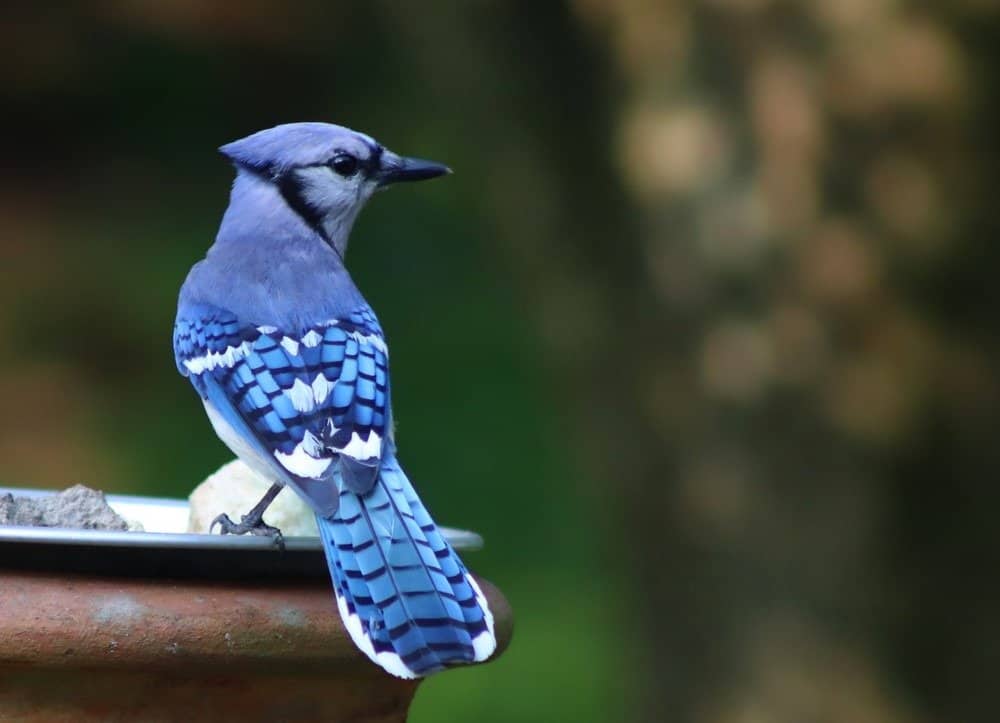
Blue jays have multi-hued blue wings are strongly barred with black and white.
©Eleanor McDonie/Shutterstock.com
Blue jays are native to North American, found throughout Southern Canada, and Eastern and Central United States. They range as far south as Texas and Florida and can occasionally be spotted in the Pacific Northwest. Most populations are sedentary in their habitats, with Southeastern Canadian jays moving farther south for winter. Blue jays live in a variety of habitats, including mixed woodlands and spruce-fir forests.
Azure Jay
The azure jay (Cyanocorax caeruleus) is the largest South American corvid. Azure jays weigh almost ten ounces and are 16 inches long. This species is an intense bright blue body, with deeply contrasting black heads, throats, and chests. The only difference between male and female azure jays is their size; females are slightly smaller.

The azure jay has an intense bright blue body, with a deeply contrasting black head and chest.
©reisegraf.ch/Shutterstock.com
These birds have a small range in South America, where they live in the Atlantic Forest. They live Southeastern Brazil, Eastern Paraguay, and Northeastern Argentina, in the humid forest canopy, feeding on araucaria seeds, insects, and fruit. The azure jay is also highly intelligent, and forms organized groups with well-structured hierarchies.
Steller’s Jay
The Steller’s jay (Cyanocitta stelleri) is closely related to the blue jay, with plumage variation based on its range. Northern populations have black and brown heads, while farther south the jays have blue heads. They have light streaks on their heads, silvery-blue breasts and backs, and rich blue tails and primary feathers. The Steller’s jay has a flashy crown, a slender bill, and long legs.

The Steller’s jay is the only species of crested jay west of the Rockies.
©dimostudio/Shutterstock.com
Unlike the blue jay, this species is found in the Western United States and the mountains of Central America. They live in pine-oak and coniferous forests and are the only species of crested jay west of the Rockies. This jay has a varied diet, feeding on seeds, nuts, berries, insects, and small rodents. Stellar’s jays are not shy, and will scavenge picnics and campsites, if given the opportunity.
Green Jay
Green jays (Cyanocorax yncas) have distinctive bright plumage. Their bodies are a rich green color above and bright yellow to pale green below, with bluish-green tails. Their heads are deep blue with black necks, but some subspecies have yellowish-white head feathers. Some populations have dark brown irises, while others have bright yellow.

Green jays live in Central America but can venture as far north as Southern Texas
©iStock.com/Wildnerdpix
These green birds live in Central America but can venture as far north as Southern Texas and as far south as Honduras. Green jays live primarily in woodlands and shrublands, where they forage on a wide variety of insects and grains.
Plush-Crested Jay
The plush-crested jay (Cyanocorax chrysops) is a medium-sized corvid with an elegant appearance. These South American birds have rich, dark royal to navy blue plumage, with a yellowish-cream colored breast and tail tip. They also have deep black, fluffy-looking crests atop their heads and bright yellow irises.
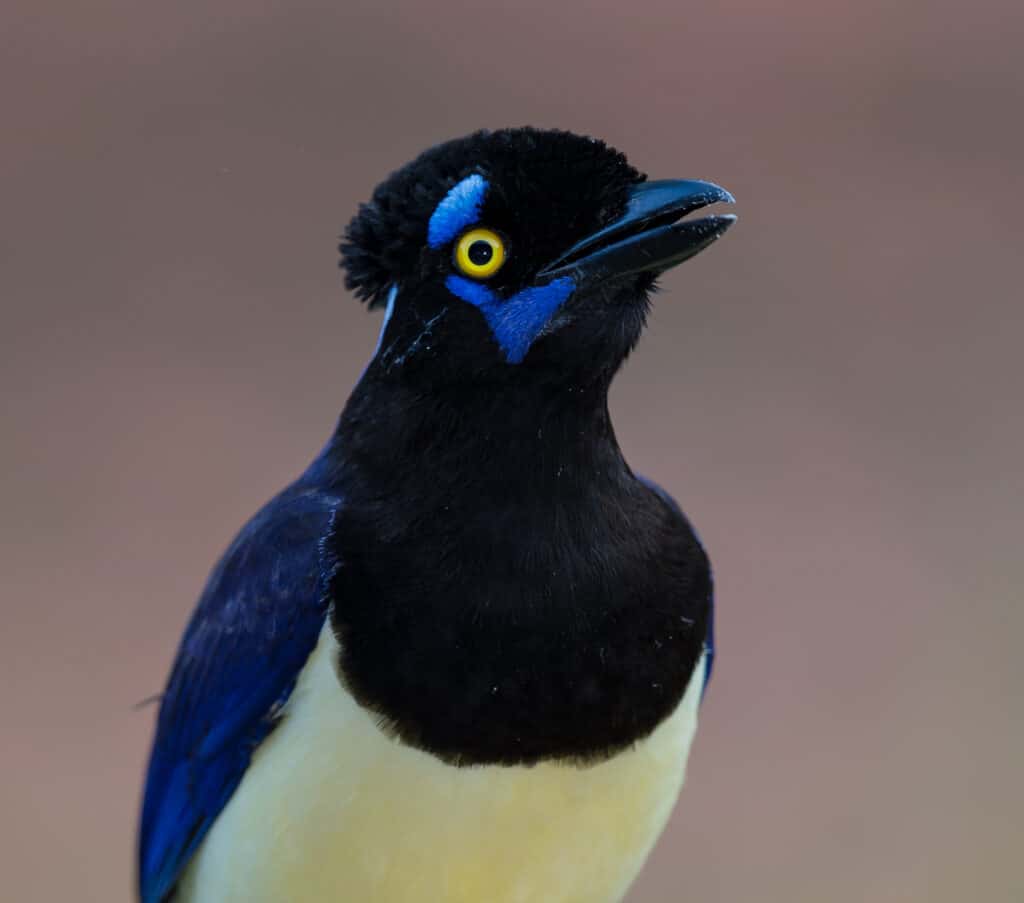
The plush-crested jay (
Cyanocorax chrysops) is a medium-sized corvid with an elegant appearance.
©jo Crebbin/Shutterstock.com
These striking birds live in South America in Brazil, Bolivia, Paraguay, Uruguay, Argentina, and the Southern Amazon River Basin. Plush-crested jays reside in wooded and forested areas near headwaters, including rainforests. They spend their days foraging for fruits, insects, eggs, snakes, and frogs.
Pinyon Jay
Pinyon jays (Gymnorhinus cyanocephalus) are highly social North American birds. Their bodies are a shadowy blue color with royal blue heads, greyish-blue undersides, and white throats. They are medium-sized birds with relatively short tails (compared to a miniature crow) and long, dagger-like bills.
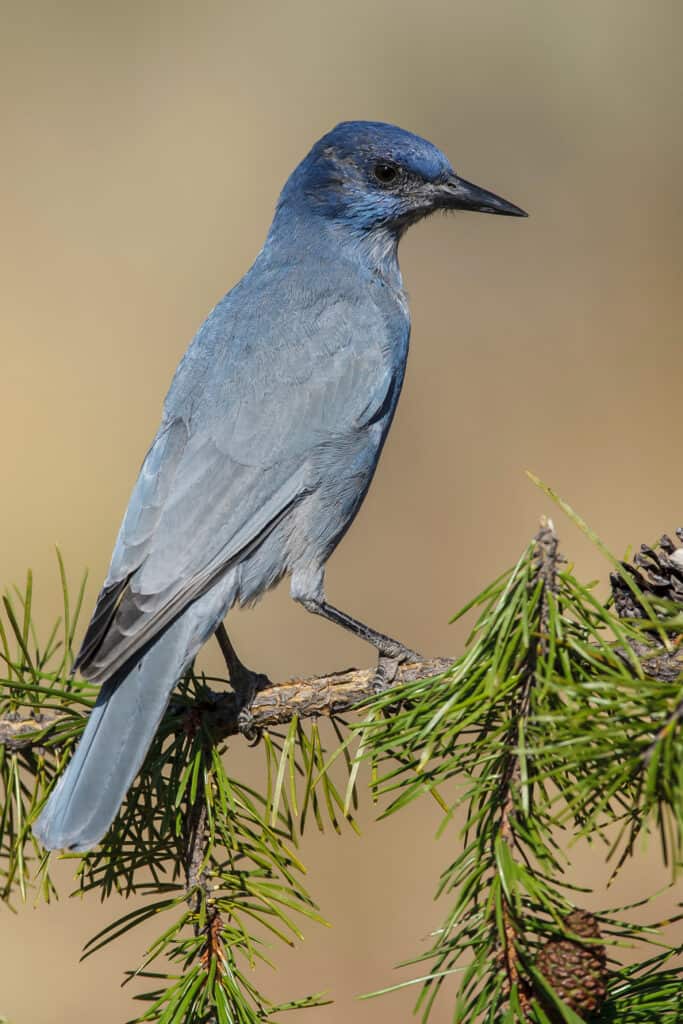
Pinyon jays are native to Western North America, from Oregon to Mexico (Baja California) and as far east as Oklahoma.
©Agami Photo Agency/Shutterstock.com
This species is native to Western North America, from Oregon to Mexico (Baja California) and as far east as Oklahoma. They reside in pinyon pine forests near foothills, where they forage for seeds in large, tightly packed flocks. Pinyon jays are frequent visitors to backyard feeders. To attract them to your yard, provide sunflower seeds, cracked corn, peanuts, and suet.
Of note: The pinyon jay is the only member of the genus Gymnorhinus.
White-Naped Jay
The white-naped jay (Cyanocorax cyanopogon) is rare and largely unstudied. They are medium-sized corvids endemic to tropical and subtropical lowland forests in Brazil. They have long, narrow tails and broad, pointed bills. Adults are medium-brown above and white below, with black heads and light markings on their eyebrows. The white on their chests extends around the backs of their necks and heads, and a short black crest rests atop their heads. Their tails are brown, but the clipped tails are dipped in white.
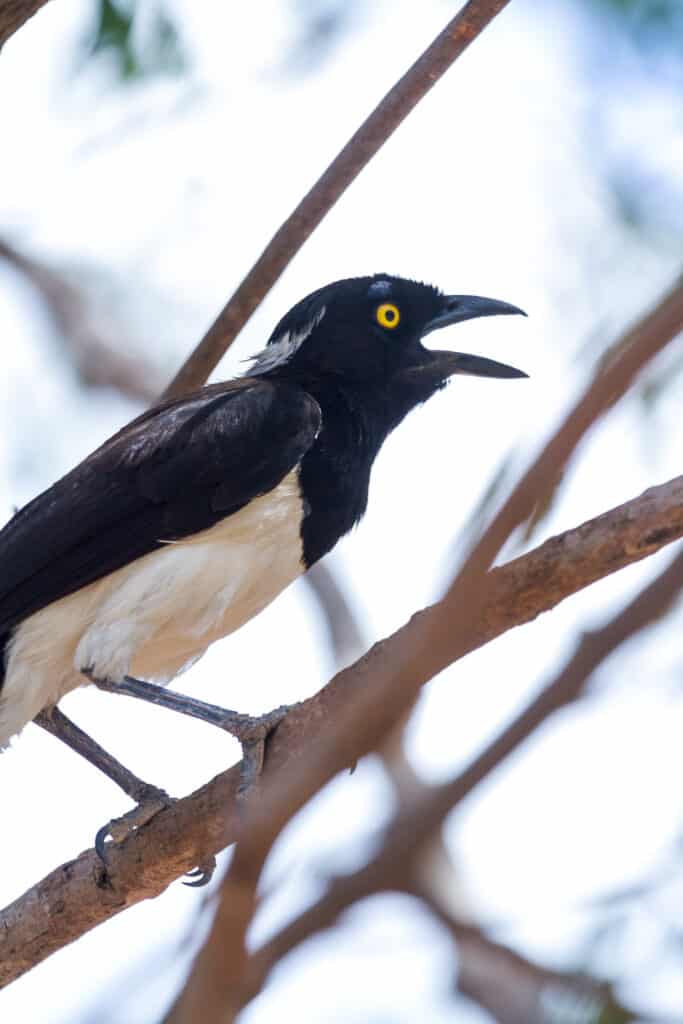
The white-naped jay is rare and largely unstudied.
©Pedro Helder Pinheiro/Shutterstock.com
Beautiful Jay
Beautiful jays (Cyanolyca pulchra) live up to their name, featuring a stunning cyan-colored body that transitions to sky blue as it reaches the neck and fades to white at the forehead. They have black face masks and dark grey breasts. Their legs and bills are all black. Males and females appear similar, though females have a more brownish tinge on their upper bodies.

Beautiful jays (
Cyanolyca pulchra) live up to their name, featuring a stunning cyan-colored body.
©Uwe Bergwitz/Shutterstock.com
This species is scarce and unstudied, inhabiting montane and cloud forests in Colombia and Ecuador. They prefer to live in marshy areas within the forest, but they are becoming more infrequent due to habitat loss and human disturbance.
Lidth’s Jay
The Lidth’s jay (Garrulus lidthi) is a gorgeous Asian bird closely related to the Eurasian jay, although it is slightly larger with a longer tail and broader bill. Lidth’s jays have rich, chestnut brown bodies, and deep purple-blue tails and wings. Their heads transition from purple to black, and their bills are a light grey to pale yellow.
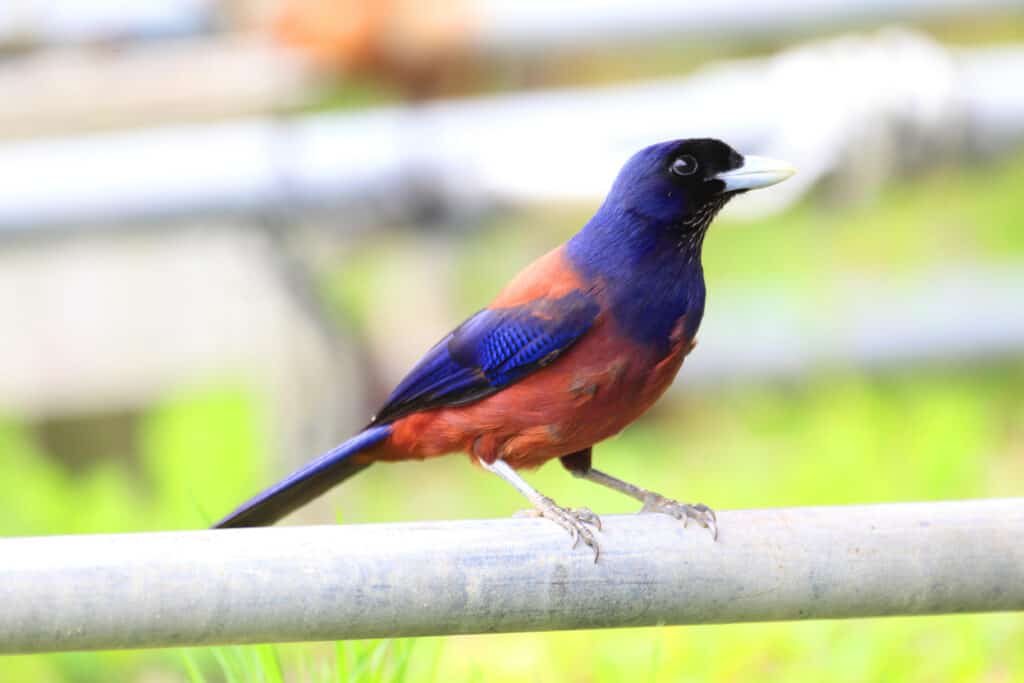
. Lidth’s jays have rich, chestnut brown bodies, and deep purple-blue tails and wings
©feathercollector/Shutterstock.com
This species is native to a very limited region on the Japanese Islands of Amami Ōshima and Tokunoshima. They live in pine forests, subtropical woodlands, and cultivated areas around villages. This jay nests in large tree cavities, and its diet primarily consists of nuts from native evergreen trees.
Tufted Jay
The tufted jay (Cyanocorax dickeyi) is a large jay endemic to a restricted area in the mountains of Northwest Mexico. They live in pine-oak forests, foraging in small, tight-knit groups throughout the canopy, often associating with steller’s jays.

The tufted jay is a large jay endemic to a restricted area in the mountains of Northwest Mexico.
©Agami Photo Agency/Shutterstock.com
This species is striking and unmistakable. Tufted jays have stiff black crests on their heads and snow-white bodies with deep blue backs and wings. The tufted jay has a unique black face mask and bright yellow irises. Its long tail appears to have been dipped in white. Not much else is known about this species, but their diet is likely to that other jays, comprised of insects, seeds, nuts, fruits, and berries.
Azure-Hooded Jay
The azure-hooded jay (Cyanolyca cucullata) is a mysterious species native to Central America, that is difficult to observe in the wild. This species is relatively large, and adults are primarily a dark blue color. They have black heads and upper chests with sky-blue crowns and napes. Their legs and bills are black, their irises are dark red. Males and females look almost identical.
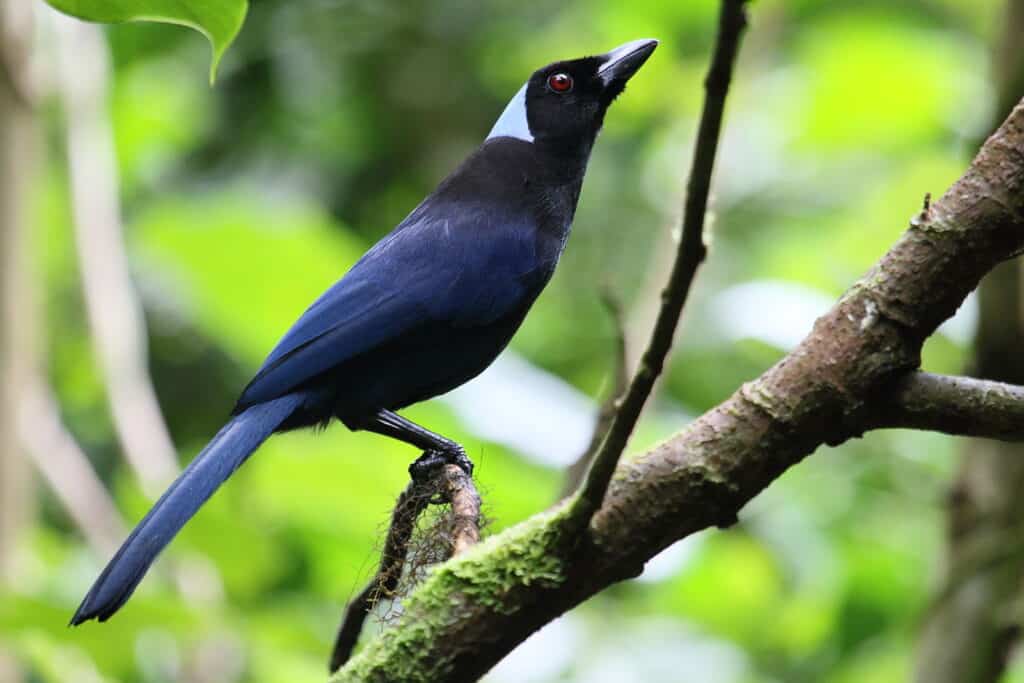
The azure-hooded jay is a mysterious species native to Central America.
©[[File:Cyanolyca cucullata Santa Elena.JPG|Cyanolyca_cucullata_Santa_Elena]] – License
This jay lives in Costa Rica, Mexico, Guatemala, Honduras, and Panama, inhabiting humid evergreen forests. You can often find them near forest edges in the middle to upper tree canopies. Like other jays, the azure-hooded jay is loud, social, and highly intelligent. They spend their days eating carrion or foraging for berries and seeds.
Up Next:
The photo featured at the top of this post is © feathercollector/Shutterstock.com
Sources
- animaldiversity.org, Available here: https://animaldiversity.org
- iucnredlist.com, Available here: https://www.iucnredlist.org
- cornell.edu, Available here: https://www.birds.cornell.edu/home/
Thank you for reading! Have some feedback for us? Contact the AZ Animals editorial team.






